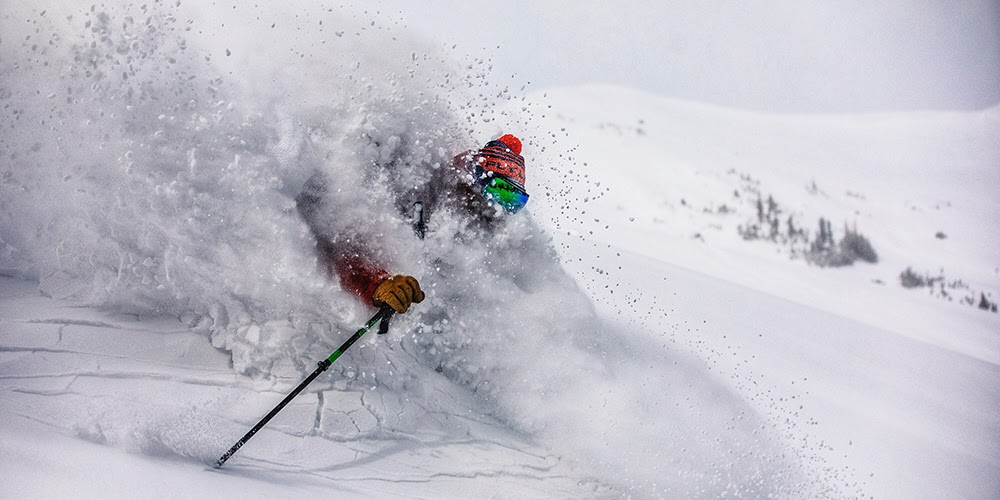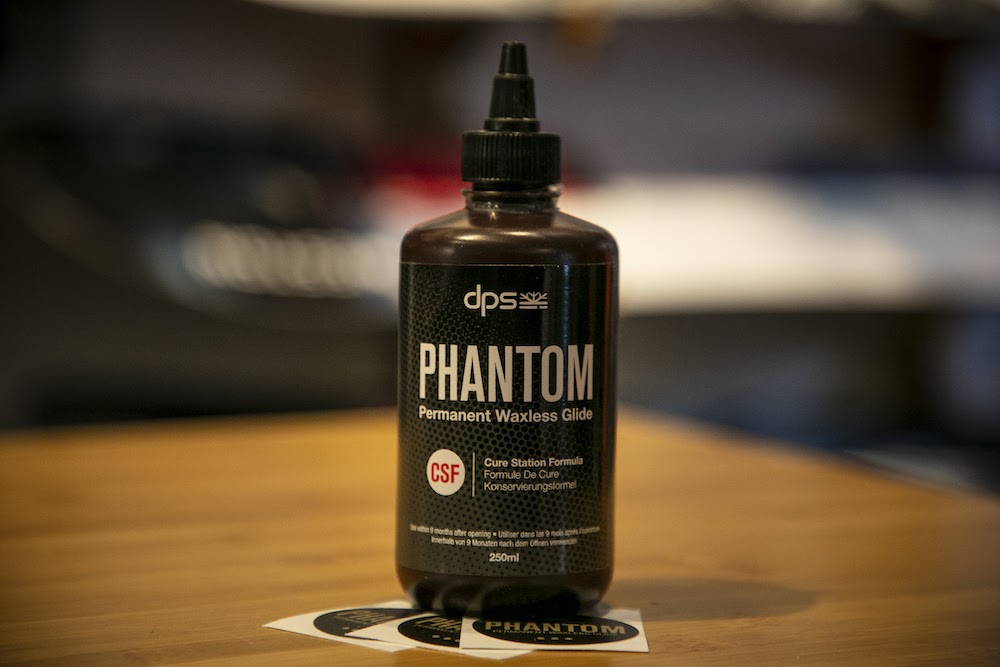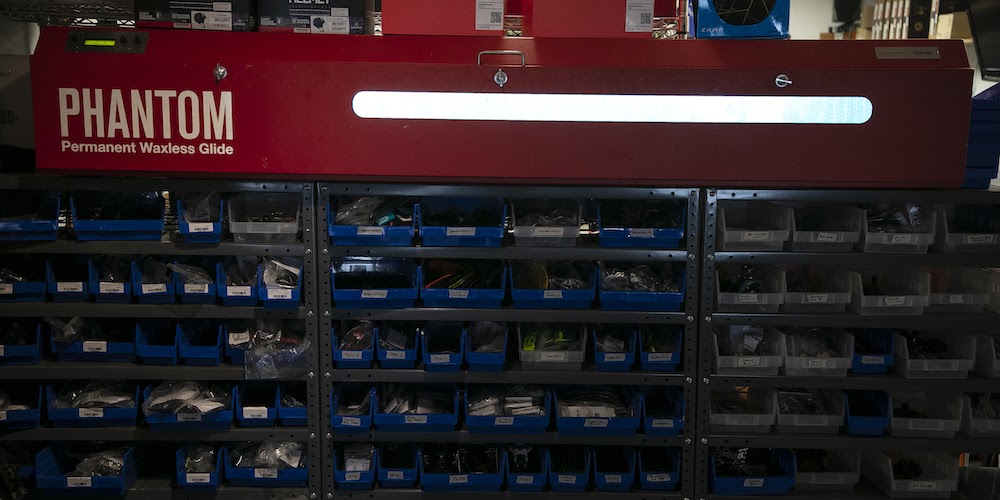
It’s easy to get lost in wax this and glide that, but the ultimate goal is to find out how we can get more of this feeling. Photo: Hugh Carey
I’d like to engage in a thought experiment together. Sit back in your chair and reminisce over a memory of skiing. Grab every recountable experience from this event. Are you gliding down a planar powder slope? Maybe hop-turning through a sun-ripened couloir? Or possibly railing G-force-inducing turns down a fresh sea of corduroy? What emotions and feelings and sensations come forth?
For me, skiing elicits feelings of flight. Skiing at its best feels weightless, effortless, and seamless. I’ll throw out a blanket-statement claim that us humans seek skiing to briefly satisfy our urge to fly. It fulfills our natural curiosity of flight in a snowy and ephemeral way. With that in mind, I began to question how can we make skiing feel most like flying? How can we minimize our drag, maximize our glide, and most closely imitate that airy sensation with wooden and plastic planks.
In search for better ski glide, I looked to what kind of products are available for our ski industry disposal. People have been putting wax on plastic ski bases for a while – that’s nothing new. However, a modern[ish] development in this field of ski glide is the DPS Phantom Waxless Glide Treatment. I wanted to learn how ski glide technology works with ski bases and ski waxes, and then what’s different about DPS Phantom. I looked into the following questions to better decide where to toss my dollars in exchange for nirvana-reaching snow-soaring:
What are ski bases and how can they help me glide?
What is ski wax and how can it FURTHER help me glide?
What is DPS Phantom Waxless Glide Treatment and how does it work differently (especially for backcountry skiing)?
Ultimately, this is a DPS Phantom Waxless Glide Treatment (DPSPWGT – how about that acronym??) review. But before getting there, I want to build an understanding of ski bases and traditional ski waxing as a foundational base of knowledge. If you don’t like belabored education on bases and wax, jump to What is DPS Phantom Waxless Glide Treatment? below.
First: A primer on ski bases
The base of ski glide is… the ski’s base. Some time long ago, we upgraded traditional wooden ski bases to plastic (polyethylene) because of the improvement in glide. The first name brand for the polyethylene ski base came from European manufacturer: International Mountain Sport. They named their product P-Tex, and the name stuck. Think of P-Tex as the Kleenex of the ski base world. P-Tex [generic polyethylene] has a high impact resistance and a low kinetic friction (<0.05 compared to 0.10 of wood when interacting with wet snow). The advent of polyethylene ski bases dramatically improved a skier’s ability to glide with a 100%+ reduction in friction compared to wooden bases. Most modern ski bases are now made from a more dense, more durable version of polyethylene called ultra-high-molecular-weight polyethylene (UHMWPE).
Glide on the new fancy UHMWPE bases is exquisite. However, this very hard material can still be damaged through prolonged abrasion from sliding on snow. The harsher the snow (frozen spring precorn, cold groomed snow), the more abrasion occurs. Bare P-Tex bases wear down and eventually fibers of base material develop. These fibers grow and increase the surface area of the base. Abrasion causes a surface area increase which causes a glide loss which causes a significant drop in bliss and glee and giggles.
To sum up ski bases: they are hard and slick, but can still get damaged by sliding on snow. So how can you stop your bases from getting beat up? Add a layer of wax to buffer the blow of abrasion.
What is ski wax?
The backcountry community isn’t very familiar with ski wax, how it works, or its correct application process. Ask most ski touring aficionados, ‘How many times do you wax your skis?’. They’ll respond with either:
Huh?
Once or twice. (no exact time frame specified)
I wax every other session, because I’m a nordic skier and not an alpine touring skier.
If we’re seeking max glide, waxing ski bases dramatically aids our efforts. So what is it? Traditional ski wax is essentially a big block of long chain hydrocarbons (along with other chemicals). By melting wax onto your skis, you add energy to the wax/base interface and help bond the hydrocarbons to the P-Tex. Unfortunately, P-Tex is so dense that there is little room for wax-base bonds to be made. This makes the glide gained from wax temporal, albeit a big improvement. What’s important to consider for ski wax performance is the temperature of the snow. Different waxes are designed for different snow types. Hot wax designed for warmer temps helps avoid base suction with the snow meltwater. Cold wax promotes the melting of snow to avoid abrasion from sharp snow crystals. Tailoring wax to specific snow conditions is where most of the glide improvements come from. It’s important to choose the right wax for the temps to reap the benefits of waxy glide.
[I don’t want to argue the nuances of ski waxing methods. But here are the most comprehensive backcountry-specific methods for ski waxing and tuning that I found to be very informative: Waxing here and tuning here. They should help you understand the correct application process for traditional ski waxing.]
To conclude: wax makes skis glide better (duh!). But eventually wax wears off. So you’ll eventually be left with a desire for more wax and more glide like a tragically addicted snow slider. What if you are searching for that fresh-waxed feel without all the wax huffing, ski scraping and base brushing of a fresh tune?
This is where DPS Phantom Waxless Glide Treatment comes into play. It promises answers. No Wax: easy. Glide: that’s what we are looking for!? Permanent: ski wax isn’t permanent! After asking and answering many questions about this treatment, I hope to dispel a comprehensive take on DPSPWGT (there’s that acronym again), how it works, and if it’s worth the cost for us backcountry travelers.
What is DPS Phantom Waxless Glide Treatment?

This is what the Phantom treatment bottle looks like. Informative? Not too much, but look at that lighting. Photo: Hugh Carey

The application process for DPSPWGT is most effective when applied to a freshly ground base. Dirt, wax and surface irregularities like scratches negatively affect the DPS Phantom application process. Photo: Hugh Carey
DPS developed Phantom through some fancy chemical engineering. They took the long chain hydrocarbons of wax and made them short enough to fit into the pores of UHMWPE (excuse my laymen’s chemistry). Next, they used UV light to bond the Phantom treatment to the polyethylene base (instead of a hot waxing iron like with traditional ski wax). I visualize this process as the base of the ski being a sponge that absorbs the Phantom Treatment. It soaks into the entire base rather than just bonding to the surface like ski wax. The intent of the application is to have a permanent waxless glide treatment (hence the product title). No waxing ever, but all of the glide-fiending benefits of a wax job. Give your ski a base grind, wax over the Phantom for particular snow conditions, or leave them dry all summer long. The Phantom will still be soaked into the base and provide an improved glide compared to a raw UHMWPE.
So what about for us backcountry skiers? I’ve decided that DPSPWGT is worth it. Backcountry skiing is complex. Route planning, terrain management, risk assessment, group dynamics, gear malfunctions, nutrition, hydration and weather forecasting are all multivariable variables of the backcountry travel equation. The less we can add to that equation, the more room there is left to focus on what matters. You don’t want to be thinking about if you put on the right temp wax when traveling through consequential avalanche terrain. That’s the large value that I deduce from the DPS Phantom Treatment. More measurable backcountry benefits from Phantom’ing my touring skis are:
Skin glue doesn’t stick to bases as readily
Globbing doesn’t happen as much when traveling through hot and cold snow (like when touring through the trees on a bluebird day)
Clear improvement in glide for long flat egresses and skate-skiing approaches
What are the downsides to the DPS Phantom Treatment? It costs about $200 for the materials and shop application (I highly recommend getting a shop tech to do the nuanced application process). That is pricey, but it’s comparable to ski waxing after ~10 wax jobs (without including time value). Another downside is that the Phantom Treatment doesn’t perfectly accommodate for ALL snow conditions, but works most effectively for the ‘middle of the bell curve’. There’s a performance drop as the snow gets extra warm or extra cold. Common snow conditions (which is 90% of the time) bring Phantom Treatment to a very comparable level with a traditional wax job.
Another thing important to address is that DPS Phantom Treatment does not tune your skis. It doesn’t magically sharpen your edges or fill in core shots. The treatment gives your bases a universal glide, but that’s just half the story to a well-tuned ski. Sharp edges and a planar base are crucial considerations when in search of ethereal ski glide.
This point brings up an interesting consideration with the DPS Phantom Treatment. The treatment leaves your bases waxless and exposes them to the harsh abrasive environment of snow. Without the wax buffer between your bases and the snow, base damage develops faster. DPS provides a buff pad to polish out these micro-hairs that develop from snow abrasion, and suggests using a tuning brush or roto brush if available. I don’t have a good handle on the long term effects of base abrasion like this, but it’s something to consider that without ski wax on bases, you are damaging the P-Tex rather than stripping wax away. My impression is that the P-Tex damage from abrasion is minimal and gets worked out easily with periodic buffing, because that’s my experience thus far.

Here’s a DPS Phantom oven at an undisclosed super secret ski shop. These ovens are what zap Phantom treatment into the bases of skis Photo: Hugh Carey
Did I perform any ‘science’ to deduce these results on DPS Phantom? No. Just a comparison between me and my backcountry partners. The experiment has lasted about a year and a half and is ongoing. The sample size is my close knit group of touring partners, all of which don’t have Phantom Treatment (unless there’s a doubleblind in the study??). This is anecdotal evidence that the stuff (one more time – DPSPWGT) works.
What’s Next?
So here we are at the end of the glide-seeking study on skis, wax, and a waxing alternative. My takeaways:
P-tex bases are very hard and don’t accept wax that well. So it’s important to wax diligently and wax often.
Ski wax is designed for particular snow, so choose the right wax for the day
DPS Phantom Treatment is a glide alternative that saves you from waxing skis. But it might promote faster abrasion of your ski bases.
Let us know if you have a sacred ski tuning ritual that you would like to share. What are peoples’ experiences with DPS Phantom Treatment? Is ski waxing a thing of that past with this new[ish] treatment? Curious to build a WS community discussion on how to promote better ski glide
See Lou’s previous Phantom coverage
Shop for Phantom or stop by your local shop to see if they’ve got the UV cooker.
Slator Aplin lives in the San Juans. He enjoys time spent in the mountains, pastries paired with coffee, and adventures-gone-wrong. You can often find him outside Telluride’s local bakery — Baked in Telluride.
